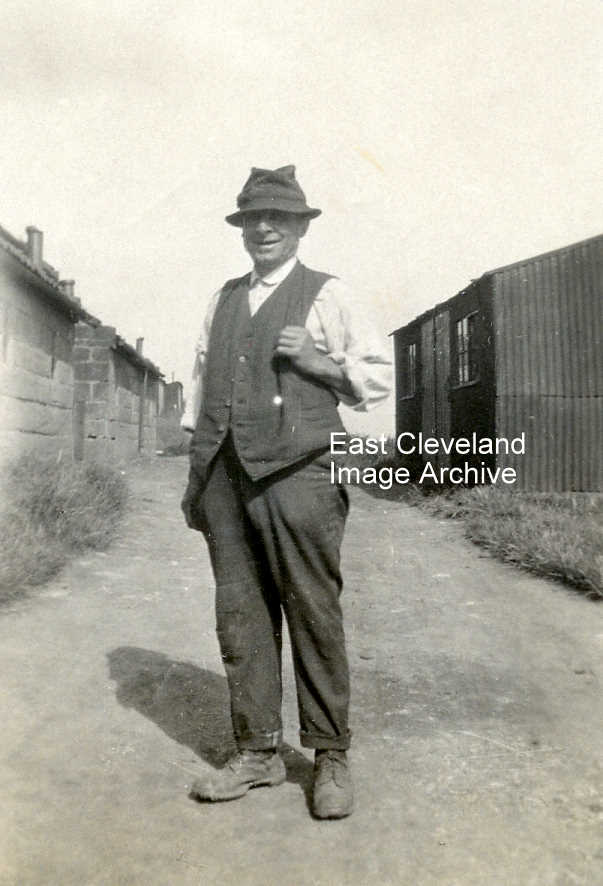
’Old’ Mr Newton at the rear of the ’Tin City’ cottages. The bungalows had wash-houses at the back with coppers for heating the water. Two of them can be seen on the right of the picture.
Image courtesy of Mr. Ray Conn.
|
|
||
|
’Old’ Mr Newton at the rear of the ’Tin City’ cottages. The bungalows had wash-houses at the back with coppers for heating the water. Two of them can be seen on the right of the picture. Image courtesy of Mr. Ray Conn.
We can identify all the men in this photograph: George Rawson, Dennis Bowman, Rev. Johnson, Harry Dack, Mr Keen, Herbert Stephenson, Bob MacLean (foreman), Stan Downes, George Gettings, Arthur Ransome.Phil Ransom told us: “Full line up, according to Mother is – George Rawson, Dennis Bowman, Rev Johnson, Harry Dack, Mr. Keen, Herbert Stevenson, Bob McLean (foreman), Stan Downs, George Gettings, Arthur Ransome. The picture is taken in Skinningrove Square where a church was to be built and this voluntary work was undertaken by the ‘brick gang’; apparently the project was stopped due to lack of money.” Derick Pearson added: “The fact that Reverend Johnson and Bob McLean were there might give an indication to what the event was and where; Herbert Stephenson was a Sample passer on the works and so would assume he was acting as a labourer here to the bricklayers.This must have been some voluntary event.” Arthur Ransome started work as a bricklayer at the Skinningrove Works when he was 14 in 1947, but left the works in the early 70’s when steel production stopped and continued as a bricklayer building many houses in the local area. The bricks in front of them could be fire bricks that were used to line the furnaces, although the ‘brick gang’ would be called upon to carry out all kinds of building work. Image from a compilation by Derick Pearson , also thanks to Derick Pearson and Philip Ransome for the information regarding this Skinningrove event.
The Archive understands this is an image members of the Hall family from Carlin How. Can anybody else assist with details? Image from a compilation by Derick Pearson.
An early picture of partially blind Mr Jacobs of Carlin How Dairy, in later life Mr Jacobs became almost totally blind, but continued to successfully run his Dairy on Brotton Road. Image from a collection compiled by Derick Pearson.
Our image portrays an occassion celebrated by Pheobe and friends. Some of whom have been identified, but we still await advice on where and why. Back row: Audrey Medcalf, ??, Mrs Dredge, ??. Front row: ??, Phoebe Dack, Mrs Briggs, Marion Barwick(nee Ditchburn), ??. Geoff tells us ”Lady fourth from left bottom row is Marion Barwick (nee Ditchburn), my mother in law’s mother, no idea what the occasion is though”. Lady in middle of front row now identified by Margaret Snowdon as Mrs Briggs who lived in Gladstone Street. Image from a collection compiled by Derick Pearson, thanks to Derick, Geoff and Margaret Snowdon (Raspison) for the updates.
The title told us it was Harry Rayson’s wedding, Kate Webster was his bride and the wedding was in 1917. We asked ”But where was the wedding?”, Sheila Drinkhall advised that it was at Brotton; further researches have shown that Kate was the eldest daughter of Thomas Webster, Confectioner of Front Street, Carlin How. Harry is wearing the uniform of a Bombardier in the Royal Garrison Artillery (part of the Royal Field Artillery). Many thanks to both Nivard Ovington and Sheila Drinkhall for their assistance in our researches.
An image of The Stray at Redcar looking a lot different to The Stray today; coastal defences were an essential part of World War II, with the ever present threat of invasion.
Ruth Davison far right was married to Eric son of the landlord and landlady of the Maynard Arms, Carlin How; Thomas Harrison Davison and Fern (nee Grocock, pre 1923). Good head on those pints Fern.
Originally entitled “The Furnaces Skinningrove” this is a different view of the square, front left of what is now the Post Office and shop with Nixon’s Bank leading up to Carlin how; as we start up the bank Hutton Street stands on the right hand side, sadly another piece of Skinningrove no longer standing. In front of Timm’s Coffee house can be seen the quoits pitch (which appear to be in use today), a popular pastime, after the pigeons, of course.
Some of the oldest houses in Skinningrove can be seen here on the right of the photograph, with the works are on the hillside in the background and I wonder what mischief the young boys were plotting? Image courtesy of Ted Morgan, via Eric Johnson. |
||
Recent Comments